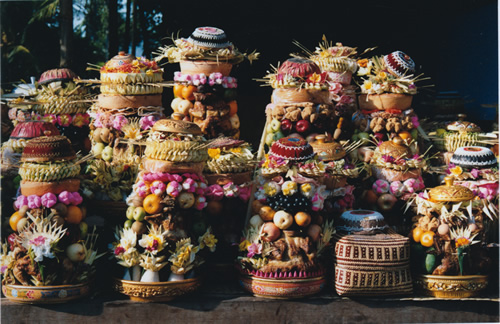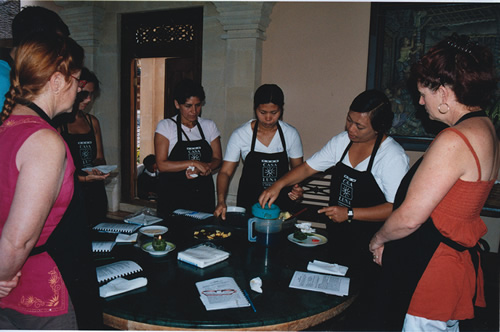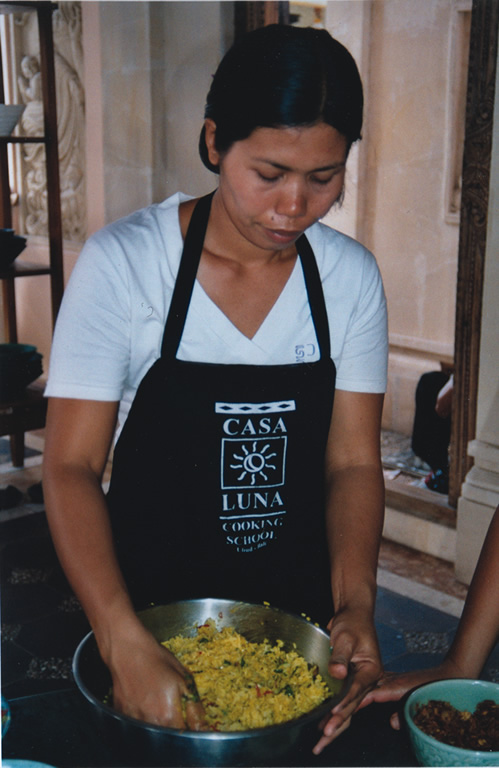A Taste of Bali: Cooking with Native Ubud Chefs
Article and photos by Lies Ouwerkerk

Offerings of food and flowers at a temple in Bali.
Mention Bali and most people will immediately think of sun, sea, and picture-perfect rice paddies with lush tropical vegetation in the background — all so very true for this South Sea island paradise. But there is definitely much more to Bali: the various arts and crafts, the typical dances, gamelan music, and Wayang Kulit theater, the Hindu temples with their many rites and festivals, the impressive cremation ceremonies, and of course, the magic food with its intriguing spices, sambals, and secret touches. In order to fully appreciate the Balinese culture, and its cuisine, a closer look at Bali's historical and religious context is imperative.
In the 15th century, as Islam swept across Southeast Asia, the last Hindu dynasty on Java fled to Bali with its entire entourage of scholars, priests, and artists. There, Hinduism was overlaid on top of the already existing animism and Buddhism, resulting in a typically Balinese interpretation of Hinduism, the so-called Hindu Dharma, which has continued to govern every aspect of life on the island up to this day, including its gastronomy.
Every morning, even before the first meal of the day is eaten, food is offered to the gods. Small trays made of neatly folded banana leaves and containing food, flowers, and incense are distributed at the numerous shrines to honor the good gods and ancestral spirits. They are also placed on the ground to pacify the evil ones, who may well be embodied in the scavenging dogs that often come to eat up the offerings as soon as they are set out.
The daily Balinese meal can be frugal, mainly consisting of rice — prepared in the morning and left in the steamer for anyone who is hungry — with some meat and vegetables added; however, there is always a hot and spicy sambal to go with it. Sambal is a crushed concoction of pungent spices and ingredients such as shredded coconut, shrimp paste, hot peppers, kaffir lime and leaves, nuts, onions, garlic, ginger, and lemon grass.
But it is for temple festivals or private celebrations, such as weddings and tooth filing ceremonies, that the Balinese dedicate themselves for hours on end to the preparation of ceremonial dishes, full of the most wonderful delicacies that often look like works of art.
For a foreigner, it is not easy to come in contact with the real Balinese kitchen, unless one has close connections with a Balinese family. First of all, Balinese recipes are handed down orally from elders to next generations, so not much is written about the Balinese kitchen. Moreover, many restaurants cater to tourists who seem to favor Western foods. To fill the gap, a few restaurants and resorts are now offering Balinese cooking classes, which are available for half a day, a whole day, or even longer. What more appropriate location to try out some of these schools than the town of Ubud, the very cultural and artistic heart of the island?
Some of the cooking schools start their programs early in the morning at the local market to give participants an idea of the ingredients that will be used in class, and then proceed in their own setting with a further explanation of the ingredients for a basic sambal, the starting point of any Balinese dish. They also demonstrate the most important tools for preparing the various dishes: a shallow stone mortar and pestle; a wooden chopping block; a woven steaming basket over a clay pot with boiling water; a variety of handy scoops, ladles, and heavy knives; a wok; and the indispensable spiked coconut scraper, as well as banana leaves, which are used to wrap food for steaming, grilling, and roasting.

Chefs at Casa Luna demonstrate how to prepare a meal to the cooking class.
The recipes invariably consist of an appetizer, which can be Rujak (sweet and sour salad) or Sup Timun (fresh cucumber in turmeric broth), a main dish such as Lawar (a combination of long beans or ferns with meat and a sambal), Pepes Ikas (grilled fish in banana leaves), or Satay Lilit (minced fish or meat on a skewer), and desserts including Kolak Pisang (braised banana in palm sugar sauce), and Kue Dadar (coconut filled crepes). At the end of each class participants feast on everything cooked during the day, and often a booklet of recipes is given to each student. Whereas the menus of the various schools somewhat overlap, there are differences in teaching style, duration, setting, and price.
- The well-prepared class of Casa Luna, taught in the charming open dining room of Honeymoon Guesthouse consisted mainly of demonstrations and explanations, rather than having participants cook themselves. There are different menus for every weekday, but a market tour is only held on some days.
-
Arma's class was taught by the assistant executive chef, who has cooked at Kokokan Restaurant. This class included a pick-up and market tour at 6:45 a.m. The otherwise gregarious cook arrived late for our class and rushed us through various recipes in less than two hours in the steaming-hot and closed kitchen of the ARMA Cafe, half by demonstration, half by student participation.
-
Cooking teacher Ni Luh Sudiani taught her class with a lot of dedication in the open dining room of the Tama Rahasia resort, just a few kilometers outside of Ubud. There were three different times set for eating the food that was prepared by the participants themselves, and at noon there was an hour of rest, which could be spent in or around a lovely swimming pool.
-
Bumbu Bali's class, taught by chef Ida Bagus Loka in an open restaurant, started with an informative market tour by the amiable chef himself. Students hardly participated during the 3-hour class, but there was ample opportunity to ask questions. Each meal course was eaten immediately after preparation. They also offer a course with vegetarian menus only.

Chef at Casa Luna demonstrates how to prepare a dish to the cooking class.
More Ubud Resources
Getting There and Around
A passport valid for at least six months and a tourist card, which can be obtained at Bali's Airport, are required for entry.
Once on the island, using a taxi is practically the only way to reach Ubud if no pick-up is arranged via hotel or travel agent. Transport in and around Ubud can be done by local bemos or taxis and motorcycles whose drivers will offer their services everywhere in town.
Where to Stay and Eat
Ubud has an enormous variety of resorts, hotels, bungalows, and guesthouses. Lower budget guesthouses and homestays can be found all
over Ubud.
There are many good restaurants with reasonable prices
in Ubud.
Sample Activities Available Besides Cooking
Classes
- Cultural workshops offered by ARMA.
- Bali Bird Walks.
- Organized trips to mountains, volcanos, fishing villages, coffee and palm sugar plantations, dances, gamelan or Wayang puppet performances.
- Snorkeling at Lembongan Island or Sanur.
- Rafting on the Ayung River.
- Biking or hiking around the rice paddies in the immediate
surroundings of Ubud.
- Shopping for sarongs, jewelry, and handicrafts.
- Batik classes.
- Massage at one of Ubud's many spas.
|
Lies Ouwerkerk is originally from Amsterdam, The Netherlands, and currently lives in Montreal, Canada. Previously a columnist for The Sherbrooke Record, she is presently a freelance writer and photographer for various travel magazines.
|
